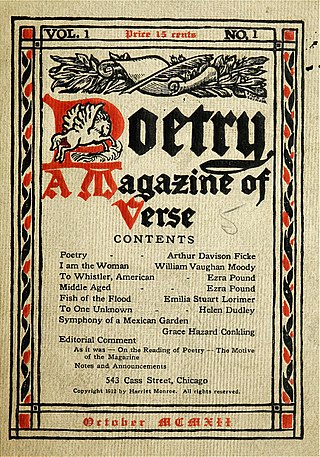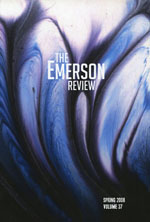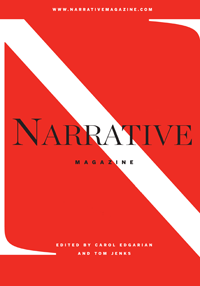
A literary magazine is a periodical devoted to literature in a broad sense. Literary magazines usually publish short stories, poetry, and essays, along with literary criticism, book reviews, biographical profiles of authors, interviews and letters. Literary magazines are often called literary journals, or little magazines, terms intended to contrast them with larger, commercial magazines.

The Kenyon Review is a literary magazine based in Gambier, Ohio, US, home of Kenyon College. The Review was founded in 1939 by John Crowe Ransom, critic and professor of English at Kenyon College, who served as its editor until 1959. The Review has published early works by generations of important writers, including Robert Penn Warren, Ford Madox Ford, Robert Lowell, Delmore Schwartz, Flannery O'Connor, Boris Pasternak, Bertolt Brecht, Peter Taylor, Dylan Thomas, Anthony Hecht, Maya Angelou, Rita Dove, Derek Walcott, Thomas Pynchon, Don Delillo, Woody Allen, Louise Erdrich, William Empson, Linda Gregg, Mark Van Doren, Kenneth Burke, and Ha Jin.

The Emerson Review, founded in 1953 as The Scribe, is Emerson College's award-winning and oldest student-run literary magazine. The book is published annually and is released each spring during a Release Event, which is open to the entire literary community of Boston.

Rigoberto González is an American writer and book critic. He is an editor and author of poetry, fiction, nonfiction, and bilingual children's books, and self-identifies in his writing as a gay Chicano. His most recent project is Latino Poetry, a Library of America anthology, which gathers verse that spans from the 17th century to the present day. His memoir What Drowns the Flowers in Your Mouth: A Memoir of Brotherhood was a finalist for the National Book Critics Circle Award in Autobiography. He is the 2015 recipient of the Bill Whitehead Award for Lifetime Achievement from the Publishing Triangle, the 2020 recipient of the PEN/Voelcker Award for Poetry, and the 2024 recipient of a Lifetime Achievement Award from the Los Angeles Review of Books.

Blackbird is an online journal of literature and the arts based in the United States that posts two issues a year, May 1 and November 1. During the six-month run of an issue, additional content appears as "featured" content. Previous issues are archived online in their entirety.

The Iowa Review is an American literary magazine that publishes fiction, poetry, essays, and reviews.

The Gettysburg Review is a quarterly literary magazine featuring short stories, poetry, essays and reviews. Work appearing in the magazine often is reprinted in "best-of" anthologies and receives awards.
Southern Humanities Review is a quarterly literary journal published by Auburn University. The current masthead consists of Anton DiScalfani and Rose McLarney (Co-Editors), Emma Brousseau, Justin Gardiner, and Maria Kuznetsova. The journal publishes fiction, poetry, and creative nonfiction. It was established in 1967 as the official organ of the Southern Humanities Council, with which it remains affiliated.
Passages North is an American literary magazine published by Northern Michigan University. Essays that have appeared in Passages North have been recognized in the anthology, The Best American Essays, on numerous occasions. The magazine was established in 1979. It sponsors the Waasmode Short Fiction Prize, the Elinor Benedict Poetry Prize, the Neutrino Short-Short Prize, and the Ray Ventre Memorial Nonfiction Prize.

Narrative Magazine is a non-profit digital publisher of fiction, poetry, non-fiction, and art founded in 2003 by Tom Jenks and Carol Edgarian. Narrative publishes weekly and provides educational resources to teachers and students; subscription and access to its content is free.

Jesse Lee Kercheval is an American poet, memoirist, translator, fiction writer and visual artist. She is an emeritus professor at the University of Wisconsin–Madison. She is the author of numerous books, notably Building Fiction, The Museum of Happiness, Space and Underground Women, and she is a translator of Uruguayan poetry.
Hot Metal Bridge was the official literary magazine for the University of Pittsburgh’s graduate Department of English. Founded in 2001 as Nidus, Hot Metal Bridge publishes fiction, poetry, creative nonfiction, literary criticism, and book reviews. Hot Metal Bridge has an open submissions policy and strives to publish a combination of established writers along with unpublished or emerging talent.
The Malahat Review is a Canadian quarterly literary magazine established in 1967. It features contemporary Canadian and international works of poetry, fiction, and creative non-fiction as well as reviews of recently published Canadian literature. Iain Higgins is the current editor.
The Bellingham Review is an American literary magazine published by Western Washington University. The magazine was established in 1977 by the poets Knute Skinner and Peter Nicoletta. The Bellingham Review includes fiction, poetry, and creative non-fiction. The current editor is writer Jane Wong. Work that has appeared in the Bellingham Review has been reprinted in The Pushcart Prize Anthology and The Best American Poetry. Notable contributors include: Micah Nathan, Jenna Blum, Anne Panning, Sheila Bender, and Deborah A. Miranda.
Hunger Mountain is an American literary magazine founded in 2002 by Caroline Mercurio. A member of the Council of Literary Magazines and Presses, Hunger Mountain is based in Montpelier, Vermont at The Vermont College of Fine Arts, one of the top-ranked low residency MFA programs in the country.
The Cincinnati Review is a literary magazine based in Cincinnati, Ohio, US, published by the University of Cincinnati. It was founded in 2003 and features poetry, fiction, and creative non-fiction. It has been listed as one of the top 50 literary magazines by Every Writer's Resource and has published Pulitzer Prize winners and Guggenheim and MacArthur fellows. Works from The Cincinnati Review have been selected to appear in the annual anthologies Best American Poetry, Best American Essays, New Stories from the South, Best American Short Stories, Best American Fantasy, Best American Mystery Stories, New Stories from the Midwest, and Best Creative Non-fiction.
The American Literary Review is an American national biannual literary magazine of poetry, fiction, and nonfiction. Since its Fall 2013 issue, ALR has been an online digital publication. Print publications are cataloged under ISSN 1051-5062.
Liam Callanan is an American author and professor of English at the University of Wisconsin–Milwaukee. His novels include The Cloud Atlas (2004) and All Saints (2007).
The Christopher Hewitt Award is an annual literary award given each June by A&U magazine for writing that addresses or relates to HIV/AIDS. One award is given in each of four categories: fiction, poetry, creative nonfiction, and drama. Awards were first given in 2013. The winners for 2013 were Lisa Sandlin (fiction), Dorothy Alexander (poetry), Terry Dugan, and Evan Guilford-Blake (drama).

Irreantum is a literary journal compiled and published by the Association for Mormon Letters (AML) from 1999 to 2013, with online-only publication starting in 2018. It features selections of LDS literature, including fiction, poetry, and essays, as well as criticism of those works. The journal was advertised as "the only magazine devoted to Mormon literature." In its first years of publication, Irreantum was printed quarterly; later, it was printed twice a year. A subscription to the magazine was included in an AML membership. Annual Irreantum writing contests were held, with prizes for short stories, novel excerpts, poems, and nonfiction awarded. The journal's creators, Benson Parkinson and Chris Bigelow, sought to create a publication that would become a one-stop resource where companies interested in publishing LDS literature could find the best the subculture had to offer. They also hoped Irreantum would highlight various kinds of LDS writing, balancing both liberal and traditional points of view.










